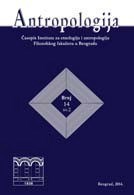УНУТАРГРУПНЕ ПОДЕЛЕ МЕЂУ СРБИМА НА ПОДРУЧЈУ ГРАДА ИСТОЧНОГ САРАЈЕВА НАКОН ГРАЂАНСКОГ РАТА У БОСНИ И ХЕРЦЕГОВИНИ 19921995. ГОДИНЕ
Intragroup Divisions among Serbs in the area of the City of East Sarajevo after the Civil War in Bosnia and Herzegovina 1992–1995
Author(s): Bogdan DražetaSubject(s): Ethnohistory, Military history, Political history, Transformation Period (1990 - 2010), Post-Communist Transformation, Inter-Ethnic Relations, Identity of Collectives, Wars in Jugoslavia
Published by: Институт за етнологију и антропологију
Keywords: Serbs; East Sarajevo; Republic of Srpska; Bosnia and Herzegovina; intragroup divisions; political divisions; institutional divisions; regional divisions;
Summary/Abstract: This paper will strive to present and perceive some of the current political, institutional, regional and other intragroup divisions between the Serbs and the Serb community in the area of the City of East Sarajevo, after the Civil war in Bosnia and Herzegovina 1992–1995. The foundation and development of Serbian Sarajevo, ie. East Sarajevo during and after the conflict, is examined along with the general geographical, economic, cultural and political context of that city. Data on the intragroup divisions of Serbs in this part of the Republic of Srpska (also called Serb Republic) and Bosnia and Herzegovina, was obtained on the basis of the fieldwork research conducted between the second half of October and the end of December 2017, as well as from mid-March to mid-May 2018. Narratives about the politics were collected through six formal and over fifty informal interviews with respondents on the current political situation and previous political developments, both in Bosnia and Herzegovina on the wider scale, as well as in East Sarajevo, on a narrower scale. Different views of the political processes and phenomena, in relation to the mainstream, have led to a gap between what has become known in the public as „the eastern and the western part of the Republic of Srpska“. The inhabitants of East Sarajevo with whom I lived, talked and participated in their everyday life, consider their region as being neglected politically, economically, and culturally. Separation among the Serbian community is not just caused by political but also institutional divisions, intertwined with each other, while regional divisions are built on the basis of cultural stereotypes about people from a particular area.
Journal: Antropologija
- Issue Year: 19/2019
- Issue No: 1
- Page Range: 141-167
- Page Count: 27
- Language: Serbian

